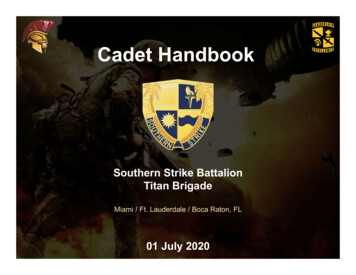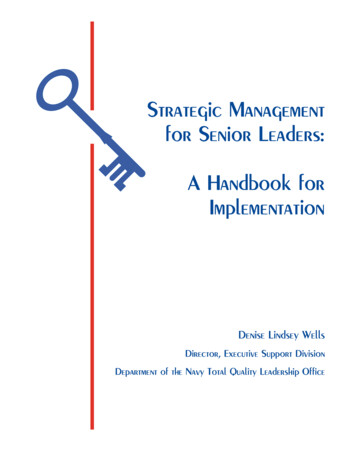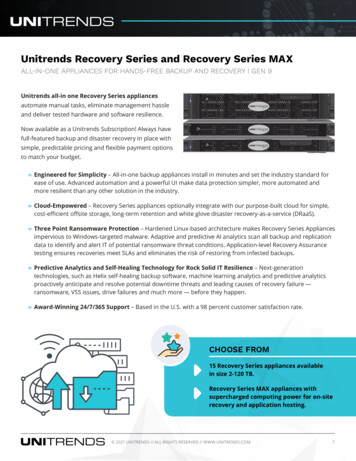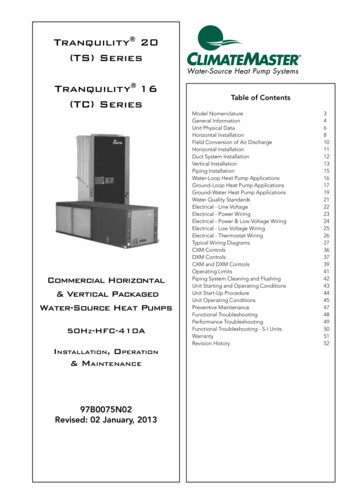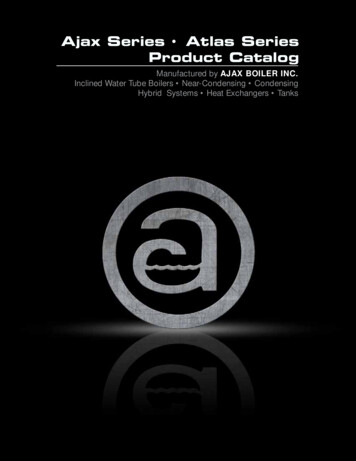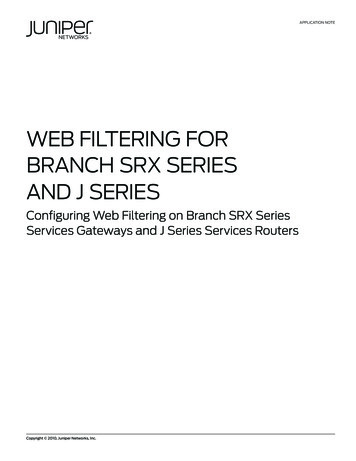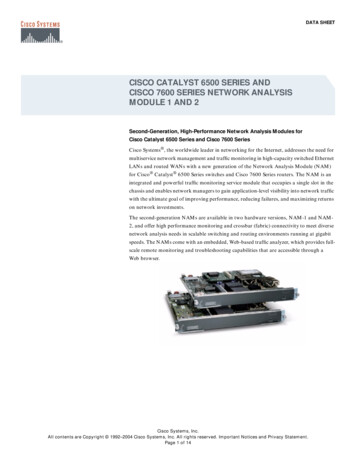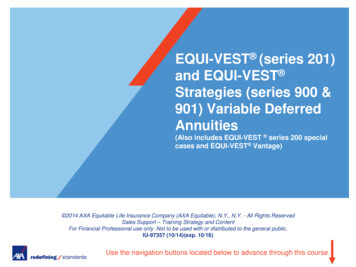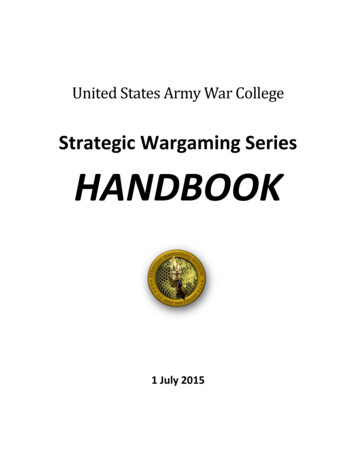
Transcription
United States Army War CollegeStrategic Wargaming SeriesHANDBOOK1 July 2015
ii
Strategic Wargaming SeriesHANDBOOKiii
2nd printing of the 1st edition. This printing includes corrections to typographical errors found in the firstprinting and is otherwise unchanged.This publication was written and edited by James Markley. Contributors included Jeffrey Brashear,William (Chip) Cleckner, Brent Kauffman, Ned Ritzman, Robert Scanlon, and Donald Travis.The views and opinions expressed in this Handbook do not necessarily reflect those of the US Army WarCollege, the Department of the Army, or any other agency of the US Government.To obtain permission to reproduce material from this Handbook for commercial purposes, contact theeditor for each use. Material may be freely reproduced for academic or other noncommercial use;however, it is requested that the Strategic Wargaming Division, US Army War College, be credited andthe editor informed.Send requests for publication and reproduction information to: Center for Strategic Leadership andDevelopment, ATTN: Strategic Wargaming Division, 650 Wright Avenue, Carlisle, PA, 17013.iv
v
Table of ContentsI. Handbook Introduction . 1Figure 1. Wargame Process Macro View . 4II. Select a Topic . 6III. Define the Wargame . 8Figure 2. Define the Wargame Phase . 8IV. Plan Wargame Support . 13Figure 3. Plan Wargame Support Phase. 13V. Design the Wargame . 15Figure 4. Design the Wargame Phase . 15VI. Develop the Wargame . 20Figure 5. Develop the Wargame Phase . 20VII. Rehearse the Wargame . 23Figure 6. Rehearse the Wargame . 23VIII. Execute the Wargame . 26Figure 7. Execute the Wargame . 26IX. Communicate the Results . 30Figure 8. Communicate Results . 30Appendix A: Selected Bibliography . A-1Appendix B: Wargame Project Team Duties.B-1Appendix C: Sample Wargame Slate . C-1Appendix D: Wargame Support Checklist . D-1vi
I. Handbook IntroductionPurpose of This HandbookThis handbook is a reference for staff and faculty of the United States Army War College (USAWC)engaged in Strategic Wargaming. It may be particularly useful to new faculty members, especially newmembers of the Center for Strategic Leadership and Development (CSLD), Department of LandpowerConcepts, Doctrine and Wargaming (LCDW), which is responsible for the USAWC Strategic WargamingSeries. It is also a resource for both US and International students at the USAWC who are interested indeveloping their own strategic level wargaming capability at some future point in their governmentservice. Finally, this handbook serves as a reference for the USAWC students enrolled in the StrategicWargaming elective.Uses of This HandbookThe handbook provides a comprehensive overview of the strategic wargaming practices in current useat the USAWC. It is thus a guide to planning, preparing, conducting, and reporting on strategic wargamesas they most commonly occur at the USAWC. It does not attempt to explain the breadth of applicationsfor wargaming methodologies. Inasmuch as wargaming is more of an art than a science, the proceduresin this handbook should not limit the creativity and flexibility of those planning and executing awargame. Rather, it articulates a holistic process to assist the wargaming project team (aka the projectteam) in developing and executing an effective wargame. After a thorough review of this handbook, thereader should have a sufficient understanding of the way in which US Army War College’s strategicwargaming division conducts wargames to be able to participate in a meaningful way as a member of aproject team.USAWC Wargaming OverviewIntroductionStrategic wargaming supports the USAWC’s education, research, and outreach missions. Through theplanning, preparing, conduct, and reporting on strategic wargames, the USAWC is able to provideinformation and insights into issues of a national or military strategic nature to inform decision-makingof the senior-most leaders of the US Army, our fellow Services, and across the Joint Force. The USAWCconducts approximately 7-8 wargames per year, principally for the Army Staff, Army Service ComponentCommands, Combatant Commands, and occasionally other DoD and government organizations.Why Wargame?Wargaming serves several purposes that are of value to the Army and other military organizations. At itscore, a wargame is a tool for exploring and informing human decision-making. Since the USAWCprimarily conducts strategically focused wargames; the ideas, issues, and insights uncovered during theconduct of a wargame can have far-reaching effects on US national and military policy, planning, anddecision-making.1
During the course of a wargame, players often discover the need to make unanticipated decisions inorder for the game to progress. The rationale associated with decisions reached in the “game-world”may illuminate the need for “real-world” decisions while also informing the decision itself.USAWC wargames generally use qualitative analytical techniques that allow for the exposure of ideas,issues, and insights not otherwise readily obtainable through the application of quantitative analyticaltechniques.While not an explicit objective of the USAWC wargaming series, there is an educational component toeach wargame. Experience has shown that players learn from each other while participating in thewargame. Most players find the exchanges of ideas and information that occur during a wargame to beprofessionally rewarding.The USAWC Strategic Wargaming SeriesFrom the USAWC’s perspective, a strategic wargame is a structured, facilitated interaction betweenexperts on a topic that will inform and assist in future strategic decision making by improvingunderstanding of the pertinent issues. Results from a wargame can provide insights and options on theemployment and appropriate application of the instruments of national power.Through the Strategic Wargaming Series, the USAWC conducts timely and relevant wargames to addressselect issues of strategic importance to the US Army and the nation. USAWC usually conducts itswargames on behalf of a sponsor to investigate, research, or analyze issues or areas that otherorganizations are not typically addressing. These wargames commonly deal with political-military issuesat the high operational to strategic levels of war.USAWC wargame participants include highly qualified experts from the USAWC staff, faculty andstudents, US and foreign government departments and agencies, non-governmental organizations,other academic institutions, and relevant think tanks from around the world. For USAWC and theparticipants, there is inherent value in the exchanges of ideas and critical thought among a highlyqualified, diverse array of wargame participants. USAWC wargames help to build and expandprofessional networks for regional and functional communities of interest.USAWC Wargaming NicheThe Strategic Wargaming Series leverages the USAWC’s unique characteristics and capabilities toaddress matters of national security interest as they relate to the instruments of national power. Thevast majority of USAWC wargames focus on the military instrument of power in general and theemployment of Landpower in particular.As an academic institution, the USAWC has a degree of freedom to address potentially contentiousissues that might not exist in other military organizations. The USAWC is home to a seasoned facultywith recognized experts covering a broad range of subjects across the military and internationalrelations domains. In addition to the faculty, USAWC students and War College fellows from acrossgovernment and the military services add valuable insights based upon extensive, diverse experiences.2
The USAWC is able to draw on as many as 80 International Fellows each year to participate in thewargame series. This select group of senior foreign military officers, while not directly representing theinterests of their government or military, enables USAWC to integrate international perspectives into itswargames to great effect.In order to foster frank and open discussion and, unless otherwise negated by the wargame sponsor,USAWC wargames are conducted under strict rules of non-attribution. Participants (players andcontrollers) may not attribute comments or discussion points to any other participant. Likewise,wargame reports will not attribute comments to any participant or the participant’s organization.Reports usually include a listing of the players’ names and organizations unless a player declines beingincluded in that list.Characteristics of the Wargame HandbookThis handbook is organized around the major phases associated with planning, preparing, conducting,and communicating wargame results. While each wargame is unique, the phases highlighted below anddetailed throughout the handbook serve as a strong foundation for the efforts of the project team thatplans and executes a wargame.As previously mentioned, this handbook explains the current process used at the USAWC to assistwargame planners in carrying out an effective wargame. Since this handbook is a reference for theUSAWC wargame project team, it contains more detail than might be found in similar books on thissubject.The Wargame Handbook is process-focused. While the overall process generally flows in sequencewhere subsequent activities are dependent upon previously completed activities, some activities will becompleted “out of order” due to time constraints or as information becomes available. Some activitiesby their nature will be iterative and, at times, the project team will find the need to revisit previouslycompleted work based on newly acquired information or feedback. It is common for the project team tobe working on activities in more than one phase simultaneously.Process OverviewThe overall wargame methodology consists of two distinct processes. The first is the process of selectingtopics to be wargamed. Topic selection is a process that occurs several times a year. The other processinvolves wargame planning and execution. The wargame lifecycle ends when the wargame teampublishes the results, typically in the form of a report.Each wargame consists of these seven major phases: Define the WargamePlan Wargame SupportDesign the WargameDevelop the WargameRehearse the WargameExecute the WargameCommunicate the Results3
Topic andInitial Problem StatmentDefine meExecute theWargameCommunicateResultsWargame ProductsPlan WargameSupportFigure 1. Wargame Process Macro ViewThe process depicted above includes a variety of opportunities for the USAWC leadership to review theprogress of the wargame planning effort and to provide guidance for further development of the plan.This handbook only documents certain critical progress review sessions. More “in-progress reviews”(IPR) may be required based on leadership preferences and the wargame topic.Wargame Personnel Requirements OverviewDesigning and executing a wargame requires a team effort. Critical roles for conducting a wargame arelisted below. These roles may be performed by any number of people with varying organizational titlesdepending on the complexity of the wargame and the skill required to ensure a successful wargame.Appendix B provides a description of the roles and responsibilities of the Strategic Wargaming Series keyleaders, project team members, and other participants in the planning, preparing, conduct, andreporting on strategic wargames.Key Leaders include:1.2.3.4.5.6.Director, Center for Strategic Leadership and Development (CSLD)Director, Landpower, Concepts, Doctrine, and Wargaming (LCDW)Director, Strategic Wargaming Division (SWD)Director, Strategic Assessments Operations Research Division (SAORD)Wargame MentorWargame SponsorKey Project Team Positions include: (See Appendix B for details and an expanded list)1.2.3.4.5.Project ManagerLead AnalystFacilitators and UmpiresReport AuthorSupport Team Members4
Central to the wargame process is the project management team that will manage all phases of thewargame process. Under the direction of the project manager, the wargame’s project team meets asoften as necessary to plan and execute the wargame. Once formed, the project team stays togetherthroughout planning and execution of the wargame.The project team defines, designs, develops, and conducts the wargame to create the conditions bywhich a diverse panel of wargame players interact to address matters of strategic importance. Wargameanalysts and report authors evaluate and refine these important interactions into products (generally awargame report) to concisely convey the wargame outcomes.5
II. Select a TopicThe wargame process begins with a topic and an initial or draft problem statement. During this phasethe Director, Strategic Wargaming Division (director of wargaming) selects the topics for the slate ofwargames and working with his team, determines an initial problem statement.Personnel Required: Director, Strategic Wargaming Division (SWD)Purpose: To create and maintain a prioritized list of viable topics for the Strategic Wargaming Series.End State: An approved wargame slate, which includes the wargame topic, wargame number, tentativedate, project management team, mentor, and report author. The initial problem statement is alsodetermined but, does not appear on the wargame slate. An example wargame slate is included inAppendix C.Selecting Potential Topics: Every July, the director of wargaming develops an initial slate of wargames(the wargame slate) for the first six months of the coming academic year. The slate is reviewed at leastquarterly and updated as appropriate.The process of selecting a topic begins with the director of wargaming soliciting ideas for wargamesfrom within the USAWC as well as from a number of external organizations, the vast majority of whichare Department of Defense (DoD) organizations and agencies.Ideas for wargame topics may come from any of the centers, schools, or institutes that comprise theUSAWC as well as from USAWC leadership. Additionally, the director of wargaming examines the KeyStrategic Issues List (KSIL) for wargame ideas. The KSIL, which includes input from a wide variety ofstrategic leaders within the Army and DoD, serves to guide USAWC student as well as staff and facultyresearch efforts.Members of the wargaming division engage in environmental scanning to identify issues and ideas forwargames. The wargaming director considers these issues and ideas for possible inclusion in thewargame slate. Finally, the wargaming director has members of the wargaming division examinepreviously completed wargames to identify issues that merit additional investigation via a wargame. Thestrategic wargaming division members also reviews previous games for changes in the strategicenvironment that would merit reconsideration of the topic for further investigation and wargaming.At the same time the wargaming director is soliciting ideas from inside the USAWC, he also solicits ideasfrom points of contact across the DoD. These organizations include Army senior leadership, the ArmyStaff, Army Service Component Commands, the Joint Staff, Combatant Commands, as well as Army andJoint organizations and agencies.6
From time to time, the director of wargaming will receive unsolicited requests from military commandsto examine a specific issue with current or immediate interest to the command. Although somewhatrare, Army or USAWC may direct the wargaming of a particular issue or topic.Evaluating Topics: The director of wargaming evaluates all the potential topics and selects those thatwill be gamed. He may include other members of CSLD in his deliberations to assist in this process.The director of wargaming is free to use his judgment and any set of criteria he chooses in evaluatingand selecting a topic. In general, a “good” topic is one that has a strategic focus, has implications for theemployment of Landpower, is a topic that is not being widely examined by other organizations, and iswithin the capability of the wargaming divisions to plan and execute effectively.Topics not initially selected may be held “in reserve” for future consideration. Circumstances might alsochange in a way that raises the significance of the unselected topic, making it more important toexamine than a previously selected topic. Additionally, continuous environmental scanning may identifychanges in the strategic environment that could negate the value of wargaming a previously selectedtopic that is no longer relevant.Since ideas for wargames can come at any time from a variety of sources, the wargaming division mayrepeat topic selection and evaluation several times a year.Develop Project Team Recommendation: Once the wargame slate is completed, the director ofwargaming will consult with the other directors within CSLD to develop the project management teamfor the wargame. Collectively, these directors will also make tentative assignment of project teammembers to include the wargame mentor, report author, and facilitation team. The projectmanagement team, in coordination with the affected directors, will make final selections of teammembers and form the project team during the design phase.Wargame Slate Review: The director of wargaming will seek approval for the wargame slate from theDirector, CSLD. The director of wargaming will revise the slate based on any input from the Director,CSLD. The director of wargaming will keep all affected directors within CSLD informed of changes to theslate and will ensure the wargame slate is kept current and shared with all interested elements of theUSAWC.7
III. Define the WargameApproximately 100 days prior to the planned start date for the wargame, the project manager and hismanagement team begin planning for the wargame by starting the ‘Define the Wargame’ phase. Thisphase begins with a scheduled topic as the input and culminates in a clear articulation of several criticalplanning factors:1.2.3.4.5.6.Wargame Problem Statement, Purpose, Objectives, and Research QuestionsStakeholder AnalysisIdentified Risks and Risk ManagementWargame Limitations (Assumptions, Constraints, Restraints and other limitations)Desired Wargame ProductsWargame MilestonesPersonnel Required: Project management teamPurpose: To clarify the game problem statement, purpose, objectives, and research questions (PPOR)before designing the wargame.Endstate: A person external to the project team should be able to understand in a single reading theprecise intent of the wargame as well as critical planning factors that will affect the wargame design.An overview of the ‘Define the Wargame’ phase is shown below.PerformStakeholderAnalysisTopic and InitialProblem ResearchDevelopProblem Statement,Purpose,Objective(s),Research Question(s)DetermineLimitationsIdentify andManage RiskEstablishWargameMilestonesDefine IPR Briefto DirectorLCDWWargameDefinition Briefto Director CSLDFigure 2. Define the Wargame Phase8Approved WargameDefinition
Perform Background Research: The project management team, with assistance from the wargamementor, can begin background research on the topic at any time, but should begin no later than 100days prior to the execution of the wargame. Background research helps the project team to betterunderstand the issue to be wargamed and forms the basis for scenario development. This initialresearch leads to a more informed wargame definition and design and is essential to the conduct of ahigh quality game. The project management team focuses its research on the strategic context of thetopic in order to gain a better understanding of the relevant issues. During research, the projectmanagement team considers how the topic is relevant, strategic, related to Landpower, and how it fitsthe War College niche.For wargames with a sponsor, the project management team usually consults with the sponsor forpreliminary information and often returns to the sponsor multiple times throughout the wargameplanning process to ensure planning is on track with sponsor expectations.Develop Wargame Problem Statement, Purpose, and Objective and Research Questions (PPOR): Theproject management team develops the wargame’s PPOR during one or more planning or brainstormingsessions. The project management team will invite subject matter experts to attend these sessions. Asthe project team learns more about the wargame topic, development of PPOR may be iterative,requiring several working sessions. The PPOR is critical as they set the conditions for the rest of thewargame; they must be clear and reflect what the USAWC (or sponsor) desires to achieve from thewargame. Problem Statement: A clear description of the issue to be addressed by the wargame. The problemstatement will directly affect the determination of the purpose, objectives, and research questionsthat drive the design, development, and execution of the wargame. An example Problem Statement:As US military involvement in Afghanistan begins to decline drastically in 2014, US strategicinterests linked to Afghanistan and strategic options available to the US will likely change. Notonly are future US interests in Afghanistan not well understood, neither are the interests andobjectives of the major actors in the region. Purpose: A declarative sentence that summarizes why the wargame is being conducted. Thepurpose statement provides the motivation behind the entire wargame planning process. Anexample Purpose:The purpose of this wargame is to provide US policymakers with information and insights to aidin determining future policy toward Afghanistan after 2014. Objectives: Describe a series of goals that support the wargame purpose. Example Objectives:1. Identify US national interests and their intensity in Afghanistan and the surrounding region.2. Identify the national interest of the countries bordering (neighboring) Afghanistan.3. Identify US policy options that support US national interests in Afghanistan in light of theinterests of Afghanistan’s neighbors. Research Questions: The research questions are drawn directly from the wargame objectives. Theresearch questions are intended to identify the facts or information needed to accomplish the9
wargame objectives. The research questions directly influence the development of the wargamedesign, in particular the analytical and facilitation plans. Example research questions:1. What are the US national interests in and around Afghanistan?2. What is the intensity level (vital, important, or peripheral) of each interest?3. What policy options support US national interests in Afghanistan in light of the interests ofAfghanistan’s neighbors?Perform Stakeholder Analysis: Stakeholders include all those individuals and organizations that mayaffect or be affected by the findings or outcome of the wargame. Stakeholders are characterized by theirlevel of interest in the wargame and its outcomes and their ability to impact planning and execution ofthe wargame.For stakeholders with a high level of interest and ability to impact the wargame, the projectmanagement team directly engages with the stakeholder to keep the stakeholder well informed and tomanage expectations. For stakeholders with limited interest and ability to impact the wargame, theproject management team generally monitors the stakeholder’s interest and does not otherwise consultthe stakeholder in the planning and execution of the wargame.Wargame sponsors are a particularly important type of stakeholder. Sponsors can have varying levels ofinvolvement in the planning and execution of a wargame. Some sponsors will be satisfied with merelysupplying a wargame topic, while other sponsors will be intricately involved in all aspects of thewargame. When working with a sponsor, the project team will need to determine early in the planningprocess what level of involvement the sponsor desires. The sponsor and project manager coordinatewith each other to gain a mutual understanding of who will perform which tasks, when, and to whatstandard. A part of that understanding includes determining who will make which decisions and whenthose decisions need to be made.As stakeholder analysis is completed, the project team produces a short concept paper that explains theproblem statement, purpose and objectives of the war game, and identifies any significant wargamestakeholders. This information paper is sent to the Commandant, USAWC requesting approval toproceed with further planning and development of the wargame. If requested, the project manager anddesignated members of the chain of command will provide the Commandant with a face-to-face briefingon the wargame concept.Determine Wargame Limitations: Once the project management team completes the stakeholderanalysis, the team determines wargame limitations based on research, stakeholder analysis, and thedevelopment of the PPOR. These wargame limitations can take a variety of forms and may includecertain assumptions, constraints, restraints, and other limiting factors that affect wargame planning andconduct. Wargame limitations may be internally or externally focused. For the purposes of thishandbook, assumptions, constraints, restraints, and limiting factors are defined below. (Derived fromJoint doctrine – JP 1-02.)10
Assumption: A supposition on the current situation or a presupposition on the course of futureevents. Assumptions typically come into play in the development of scenarios that deal with thefuture.Constraint: A requirement placed on the project team for the design, development, and conductof a wargame by a higher headquarters, especially a wargame sponsor that dictates a certainrequirement. Typical constraints may include the necessity of conducting the wargame at aparticular level of classification or being directed to use specific facilities for the wargame.Restraint: A requirement placed on the wargaming division for the design, development orconduct of a wargame by a higher headquarters or wargame sponsor that prohibits a certainaction. A typical restraint might include the necessity to limit scenario development to anarrowly defined aspect of a particular wargame topic or to only involve players from a specificorganization or institution.Limiting Factors: Any restriction on the freedom of action of the project team to plan or conductthe wargame. Typical limiting factors would include the availability and capacity of facilities orwargaming personnel that might limit how the wargame will be executed.Generally speaking, wargame limitations restrict the project team from doing something or compel theproject team to do something while planning and executing the wargame. The project team may acceptthe limitations or seek ways to mitigate the impact of the limitations on their efforts.Identify and Manage Risk: Risk identification and management is an ongoing activity throughout thevarious phases of the wargaming process. It starts within the design phase and continues until the finalwargame products have been released.Risks are often a function of the previously identified limitations for the wargame. The most commontechnique for determining risk is to use one or more brainstorming sessions with the projectmanagement team and later the project team, as a whole. Lessons learned from previous wargamesmay also be a source for identifying risks.Once identified and understood, the project management team manages the risks using one or more ofthe three following techniques: Avoid the risk, mitigate the risk, or accept the risk. When the projectmanagement team chooses to avoid the risk, they take action to change the wargame plan(s) in order toeliminate the risk. When the project management team c
Inasmuch as wargaming is more of an art than a science, the procedures in this handbook should not limit the creativity and flexibility of those planning and executing a wargame. Rather, it articulates a holistic process to assist the wargaming project team (aka the project . In addition to the faculty, US


